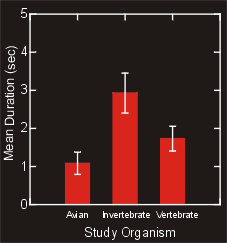![]()
We measured several parameters of laser performance: Usage, Shapes, and Duration. Usage was simply whether or not a laser pointer was used (a laser pointer was available to all subjects). Shapes were the shapes formed by laser movement. Ten distinct shapes were observed. Duration was the mean duration of each pointing bout.
In addition to laser pointer behavior, subject social status (faculty, post-doc, student), gender, population of origin (eastern or western US or foreign), and niche (animal/area studied) were recorded.
|
Interestingly, subjects who used more shapes did so for shorter durations (r^2=0.192, p=0.004). Multivariate analyses were then performed. MANOVA was used to determine whether gender, social status, population of origin, or niche affected the number of shapes used by each subject or the duration of shape use. Those shown to be significant were subject to discriminate analysis. Surprisingly, only niche (animal/area studied) affected laser pointer performance. More subjects who studied vertebrates used laser pointers than those who study invertebrates (Pearson chi^2=3.889, p=0.049). Further, subjects differed in their use of accessory communication signals depending on whether their niche was invertebrate, vertebrate (non-avian), or avian (MANOVA; F=3.602, p=0.01). Those subjects that study birds used the most laser pointer shapes, but for the shortest durations, followed by those that study other vertebrates. Those subjects that study invertebrates use the fewest shapes. Preliminary data suggests that theoreticians use laser pointers less than subjects that study invertebrates. While accessory communication signals can be valuable, we suggest that the most efficient use is of a few signals of sufficient duration to focus audience attention on the signal, indicating that subjects that study invertebrates use this behavior most efficiently. Given the showy nature of their organism, we are not surprised that subjects who study birds use the most shapes. |
 |
 |
| We have begun analysis of actual shapes used (as opposed to simple number of shapes), but as yet the pattern remains unclear. Some natural groupings (e.g., tamarins) show great similarity while others (e.g., isopods) appear to be highly variable. |  |